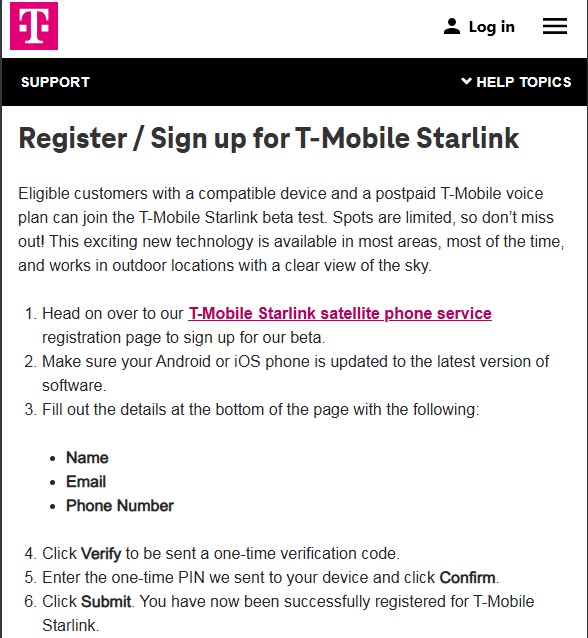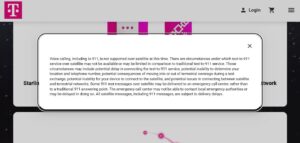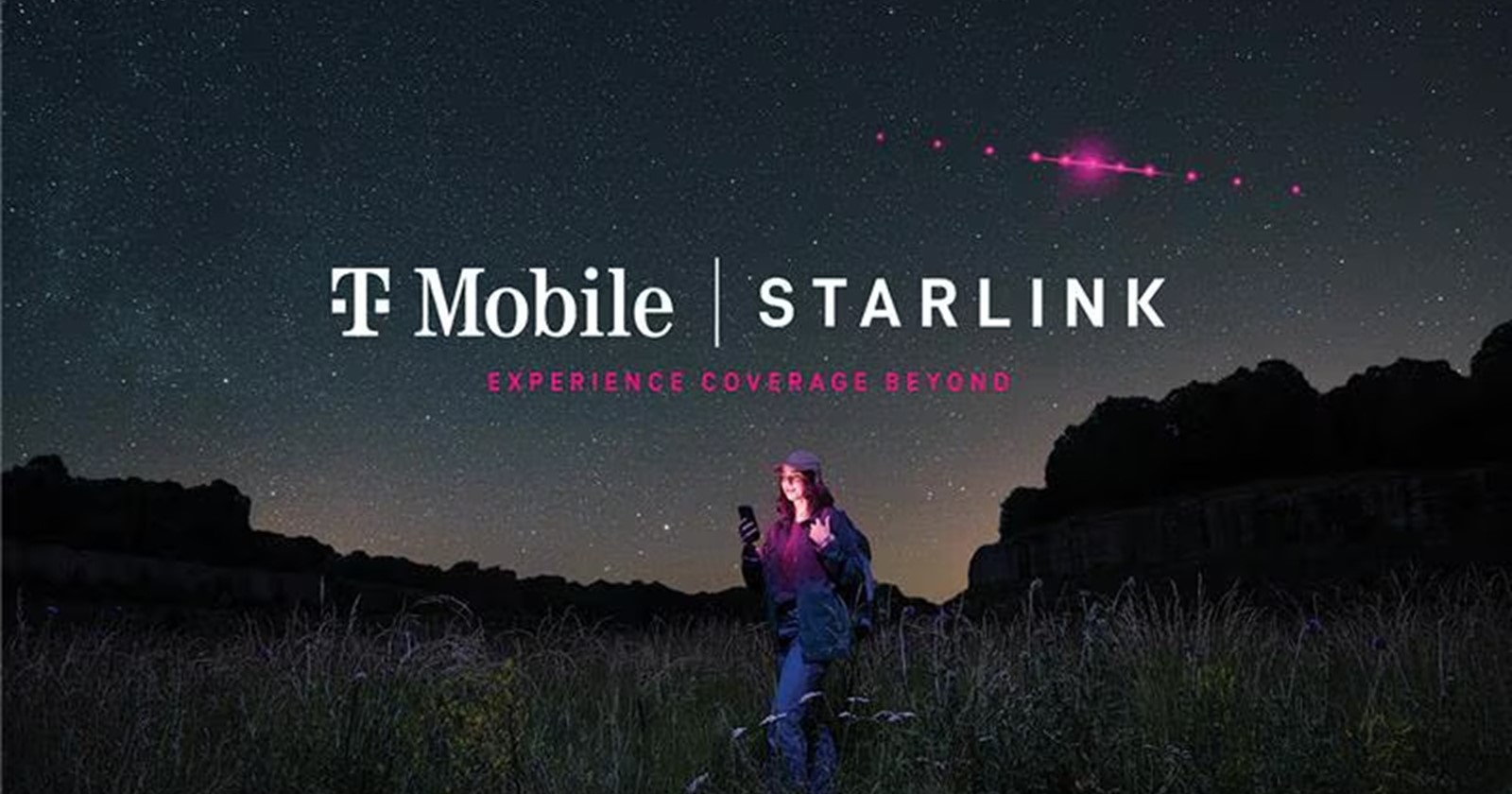Update 10/02/25: T‑Mobile just dropped a press release that’s as exciting as it is reassuring, and it turns out the whole “satellite spying” drama might be more sci‑fi cool than privacy apocalypse after all.
During the country’s biggest annual sporting event (yep, even football fans got a taste), T‑Mobile unveiled its Starlink Beta to tens of millions of users. The service uses “Direct-to-Cell” technology from satellites zipping around over 200 miles up in space to deliver your texts — and eventually picture messages, data, and voice calls — in areas where regular cell towers just can’t reach. If you’re in a dead zone and the only thing above you is a sky full of stars, your phone might automatically connect to this space-based network. And don’t worry — it still won’t force itself onto your device like an unwanted app update.
Yes, your phone will connect automatically when it’s out of range of traditional towers, but only if you’re in an area with a clear view of the sky. Think of it as having a backup plan for emergencies (like when you’re lost on a mountain trail or unexpectedly off the grid). Sounds convenient, right? But I can already hear the privacy-conscious among you muttering, “Great, so my phone is now pinging Elon’s satellites without my permission?” Not so fast.
T-Mobile has clarified that this is strictly for emergencies and basic connectivity. Right now, your phone won’t suddenly start streaming Netflix via satellite while you’re lost in the woods. And while the service can triangulate your location to connect you, it’s not exactly the dystopian tracking scenario some folks were fearing. At least, not yet. Also, if you’re the type who loves to choose what connects to your device, you can rest easy: T‑Mobile Starlink Beta is completely opt‑in. The press release makes it clear that there’s no secret “always on” mode lurking behind the scenes.
The beta isn’t just for T‑Mobile diehards — Verizon and AT&T customers get a shot at trying out the service too (with text messaging free during the beta!). For now, the beta is free until July, with special pricing for early adopters. Later, the service will roll out on select plans at no extra cost, or at a modest monthly fee for others. In short, if you’ve got a compatible smartphone from the last four years and can see the sky, you’re in!
T-Mobile is throwing in some perks to sweeten the deal. If you’re on their Go5G Next plan, Starlink access will be included at no extra cost starting in July. For everyone else, it’s $15/month per line (or $15/month per line) (or $20/month if you’re on Verizon or AT&T). And if you’re an early adopter, you can snag a $10/month discount during the beta. Not bad for what’s essentially a satellite-powered safety net.
Oh, and let’s not forget the Wireless Emergency Alerts (WEAs). T-Mobile Starlink will broadcast these alerts nationwide, so even if you’re off the grid, you’ll still get critical updates about severe weather, natural disasters, or, you know, the occasional alien invasion. (Okay, maybe not that last one… yet.)
The new release paints a picture of a future where your phone can seamlessly bridge the gap between terrestrial towers and satellite coverage. It’s not just about convenience — it’s about being connected when you need it most, like during emergencies when a text could mean the difference between stranded and saved.
T-Mobile and Starlink are aiming for universal coverage, and they’ve already roped in international carriers like Telstra (Australia) and Rogers (Canada) to join their alliance. The goal? To eliminate dead zones worldwide. Ambitious? Absolutely. A little sci-fi? You bet. But if it means never losing signal during a road trip again, I’m cautiously optimistic.
Should you freak out about iOS 18.3 and Starlink? Probably not. The update simply makes your phone compatible with satellite networks, and you’re not forced to use it. If you’re still uneasy, you can always hold off on updating or opt out of the beta. But let’s not forget the upside: this tech could literally save lives.
So, while some of us were busy worrying about “creepy” satellite triangulation and privacy nightmares, it looks like T‑Mobile and Starlink have their bases covered (and our dead zones might finally be a thing of the past). As always, read up, stay informed, and decide what works for you. After all, in this brave new world of connectivity, having options is the ultimate power move.
Original article follows:
When Apple drops a new iOS update, it’s usually cause for celebration. New emojis, bug fixes, and maybe even a fancy new feature or two! But with the release of iOS 18.3, some iPhone users are hitting the brakes — hard. Why? Because this update opens the door to T-Mobile’s Starlink beta testing program, Elon Musk’s satellite internet service, and not everyone is thrilled about it.
The Starlink beta program, initially limited to a handful of Samsung Galaxy devices, has now expanded to include compatible iPhones and Google Pixel devices. For T-Mobile users, this means the ability to connect to Starlink’s satellite network in areas with no cellular signal — handy for emergencies, but also a potential Pandora’s box of privacy concerns. And let’s be real: when Elon Musk is involved, the internet loves to have an opinion.
The concerns: Musk, privacy, and “creepy” satellite triangulation
On forums and social media, iPhone users are voicing their worries loud and clear. The main issue? Trust. Or rather, the lack of it.
One user put it bluntly: “Elon Musk has low morals and NO integrity. He cannot be trusted.” Others echoed similar sentiments, questioning whether Musk’s involvement with Starlink means their data could be misused. One person even suggested holding off on updating to iOS 18.3 altogether, writing, “I strongly suggest NOT updating until we know more.”
But it’s not just about Musk. Some users are concerned about the technical implications of connecting to Starlink. As one commenter pointed out, “Starlink cellular uses LTE. You can’t shut it off on the phone without turning off the cellular modem.” Translation: if your phone is searching for a signal, it might ping Starlink satellites — and theoretically, those satellites could triangulate your location. Creepy? Maybe. Likely? Well, that’s up for debate.
But it’s not as scary as it sounds, at least for now
Before you throw your iPhone out the window, let’s take a deep breath. Here’s the deal: iOS 18.3 doesn’t automatically connect your phone to Starlink. It simply makes your device compatible with satellite networks, should you ever need to use them. And right now, the Starlink beta is limited to a small group of T-Mobile users who’ve explicitly consented to participate. If interested, you can sign up here.

As one forum user wisely noted, “No, iOS 18.3 will NOT give Starlink access to your devices. If you CHOOSE to connect to it, you can — but you will never be forced to.” Plus, the service is designed for emergencies only, like calling 911 when you’re stranded in the middle of nowhere. So, unless you’re planning a remote wilderness adventure (or just really bad at directions), you probably won’t even notice it’s there.
That said, the concerns aren’t entirely unfounded. T-Mobile’s official documentation warns that using Starlink for emergency services might require sharing your location and phone number. And while that’s understandable in a life-or-death situation, it’s still enough to make privacy-conscious users squirm.

What happens after beta?
Here’s where things get interesting. Right now, Starlink access is opt-in for beta testers. But what happens when the program rolls out to the public? Will T-Mobile and Starlink make it an automatic feature? Or will users have to manually enable it?
At this point, no one knows for sure. But if history is any indication, tech companies tend to err on the side of convenience — which could mean default settings that favor connectivity over privacy. And that’s what’s really got people worried.
But hey, I get it. The idea of Elon Musk’s satellites pinging your iPhone feels like something out of a sci-fi thriller. But the truth is, iOS 18.3 isn’t the privacy apocalypse some are making it out to be. If you’re concerned, here’s my advice: read up on the update, understand how it works, and decide for yourself whether it’s worth the risk. And hey, if you’re really not comfortable with Starlink, you can always hold off on updating until more information comes to light.
In the meantime, let’s not forget the upside: this technology could save lives. Imagine being stranded in a remote area with no cell signal. Would you really want to sacrifice the chance to call for help just because you don’t trust the guy who owns the satellites?
Food for thought.
So, what do you think? Is Starlink a game-changer or a privacy nightmare? Sound off in the comments — just don’t blame me if Elon Musk replies.
TechIssuesToday primarily focuses on publishing 'breaking' or 'exclusive' tech news. This means, we are usually the first news website on the whole Internet to highlight the topics we cover daily. So far, our stories have been picked up by many mainstream technology publications like The Verge, Macrumors, Forbes, etc. To know more, head here.


